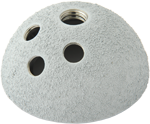
Electrochemical calcium phosphate layer: BONIT®
Technology
BONIT® is an electrochemical coating technique developed by DOT that is used to apply a thin, resorbable calcium phosphate layer on orthopaedic implants.
BONIT® Coatings - PDF: 500 KB
BONIT® coating on additive manufacturing made implants - PDF: 2 MB
Video BONIT®
Advantages of the Procedure
- Microporosity with high capillarity
- Complete and uniform coverage of porous surfaces and complex implant geometries
- No flaking of particles or coating delaminations
- Large free calcium and phosphate reservoir on the implant surface after surgery offers ideal proliferation conditions for osteoblasts
- Faster and better healing
- "Non-line-of-sight" process

Range of Application
- Joint implants: hip joint, knee joint, ankle joint , shoulder joint, wrist joint, finger implants and spinal implants
Properties
- Color: light gray
- Coating thickness: 20±10 µm
- Porosity: 60 %
- Adhesion strength: ≥ 15 MPa
- Ca/P ratio: 1.1±0.1
- Phase composition: ≥ 70 % Brushite/≤ 30 % HA
- Outstanding biocompatibility
- Fine crystalline structure with high inner surface
- High capillarity effect
SEM pictures of BONIT® surface

Plasma-Sprayed HA
At DOT, the plasma sprayed HA coating is applied to the implants in a vacuum chamber using the VPS vacuum technique. Read more>>

